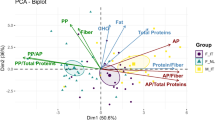Abstract
Clinicians have long recognized that thyroid hormones have some effects on the gastrointestinal tract. This study aimed to investigate the gut microbiota in hyperthyroid and assess whether there are alterations in the diversity and similarity of gut microbiota in the hyperthyroid when compared with healthy individuals. PCR-denaturing gradient gel electrophoresis (DGGE) with universal primers targeting V3 region of the 16S rRNA gene was employed to characterize the overall intestinal microbiota composition, and some excised gel bands were cloned for sequencing. Enterobacteriaceae, Enterococcus, Bifidobacterium, Clostridium, and Lactobacillus genus were also enumerated by quantitative real-time PCR. A significant difference between hyperthyroid and healthy groups (* P < 0.05) was shown in DGGE profiles. And real-time PCR showed obvious decrease of Bifidobacterium and Lactobacillus (* P < 0.05), and increase of Enterococcus (* P < 0.05) in the hyperthyroid group. This study shows the characterization of gut microbiota in hyperthyroid.

Similar content being viewed by others
References
Boon N, Windt W, Verstraete W et al (2002) Evaluation of nested PCR-DGGE (denaturing gradient gel electrophoresis) with group-specific 16S rRNA primers for the analysis of bacterial communities from different wastewater treatment plants. FEMS Microbiol Ecol 39:101–112
Fisher K, Phillips C (2009) The ecology, epidemiology and virulence of Enterococcus. Microbiology 155:1749–1757
Gafan GP, Lucas VS, Roberts GJ et al (2005) Statistical analyses of complex denaturing gradient gel electrophoresis profiles. J Clin Microbiol 43:3971–3978
Ghoshal UC, Shukla R, Ghoshal U et al (2012) The gut microbiota and irritable bowel syndrome: friend or foe? Int J Inflamm 2012:151085
Kapatral V, Anderson I, Ivanova N et al (2002) Genome sequence and analysis of the oral bacterium Fusobacterium nucleatum strain ATCC 25586. J Bacteriol 184:2005–2018
Khoruts A, Dicksved J, Jansson JK et al (2010) Changes in the composition of the human fecal microbiome after bacteriotherapy for recurrent Clostridium difficile-associated diarrhea. J Clin Gastroenterol 44:354–360
Kostic AD, Gevers D, Pedamallu CS et al (2012) Genomic analysis identifies association of Fusobacterium with colorectal carcinoma. Genome Res 22:292–298
Ledder RG, Gilbert P, Huws SA et al (2007) Molecular analysis of the subgingival microbiota in health and disease. Appl Environ Microbiol 73:516–523
Liu J, Wu D, Ahmed A et al (2012) Comparison of the gut microbe profiles and numbers between patients with liver cirrhosis and healthy individuals. Curr Microbiol 65:7–13
Ma C, Wu X, Nawaz M et al (2011) Molecular characterization of fecal microbiota in patients with viral diarrhea. Curr Microbiol 63:259–266
Muyzer G, De Waal EC, Uitterlinden AG (1993) Profiling of complex microbial populations by denaturing gradient gel electrophoresis analysis of polymerase chain reaction-amplified genes coding for 16S rRNA. Appl Environ Microbiol 59:695–700
Round JL, Mazmanian SK (2009) The gut microbiota shapes intestinal immune responses during health and disease. Nat Rev Immunol 9:313–323
Shah HN, Collins DM (1990) Prevotella, a new genus to include Bacteroides melaninogenicus and related species formerly classified in the genus Bacteroides. Int J Syst Bacteriol 40:205–208
Skillman LC, Toovey AF, Williams AJ et al (2006) Development and validation of a real-time PCR method to quantify rumen protozoa and examination of variability between entodinium populations in sheep offered a hay-based diet. Appl Environ Microbiol 72:200–206
Author information
Authors and Affiliations
Corresponding author
Rights and permissions
About this article
Cite this article
Zhou, L., Li, X., Ahmed, A. et al. Gut Microbe Analysis Between Hyperthyroid and Healthy Individuals. Curr Microbiol 69, 675–680 (2014). https://doi.org/10.1007/s00284-014-0640-6
Received:
Accepted:
Published:
Issue Date:
DOI: https://doi.org/10.1007/s00284-014-0640-6




